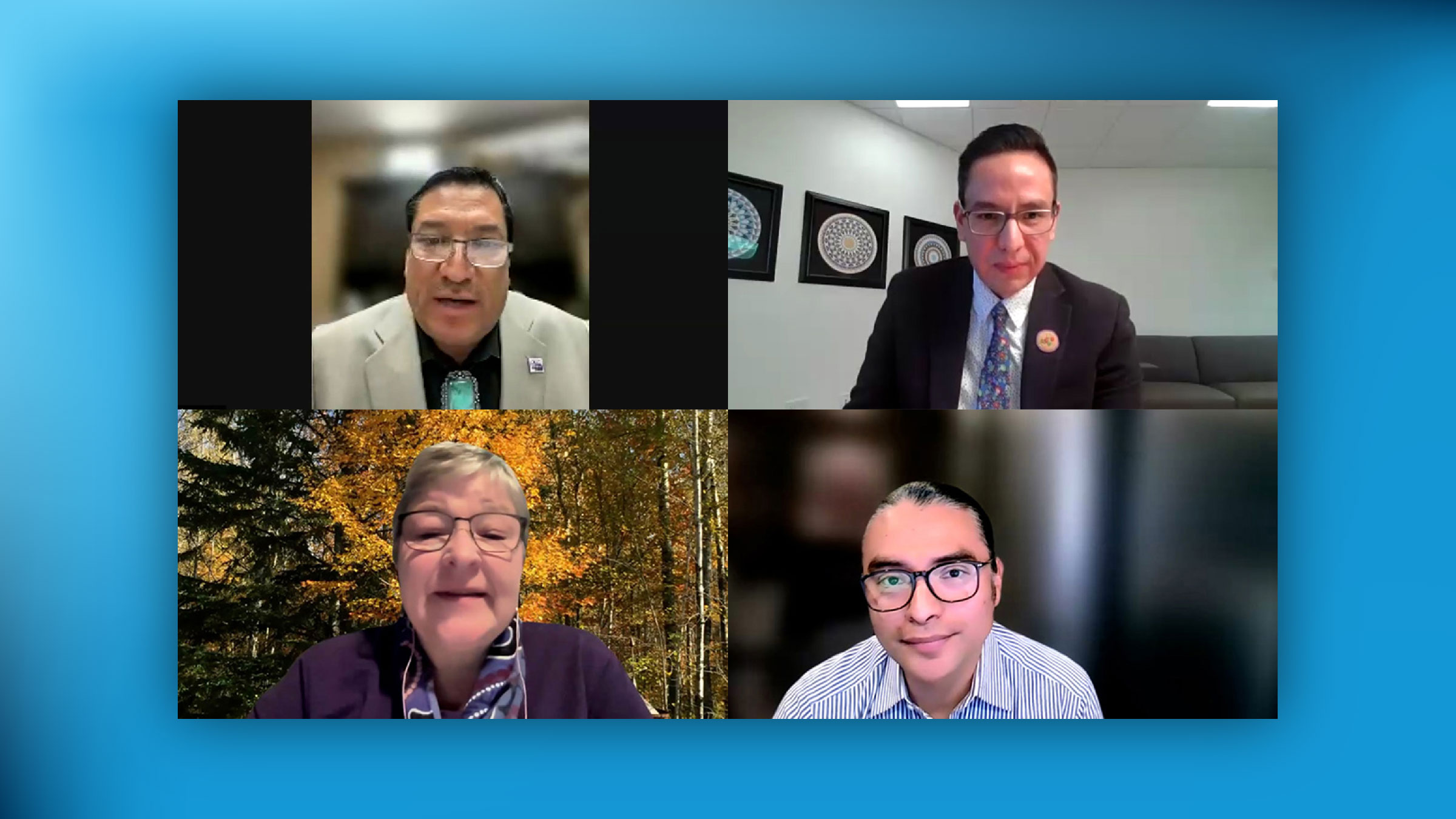In a movement that was millennia in the making, and that looks out seven generations into the future, this is a moment.
Speakers at the 2024 Center for Indian Country Development (CICD) Data Summit, held on November 13, celebrated growth in Native communities’ economic data capacity. Tribal leaders, policymakers, and academic researchers shared data innovations across Indian Country that have coincided with a burgeoning Indigenous data sovereignty movement in the past decade. Their stories braided contemporary digital advancements, lessons from ancestors’ safekeeping of information, and hopes for future generations.
Every year since 2021, CICD has hosted the virtual summit as part of its work to advance the economic self-determination and prosperity of Native nations and Indigenous communities through actionable data and research. More than 700 Indian Country stakeholders registered for the 2024 event.
Indigenous data sovereignty: A decade of growth
Stephanie Russo Carroll (Ahtna-Native Village of Kluti-Kaah), director of the Collaboratory for Indigenous Data Governance and a member of CICD’s Leadership Council, set the stage for the day’s conversations with a primer on the Indigenous data sovereignty movement.
“At its most basic level, Indigenous data sovereignty is about the right to govern the collection, application, storage, and use of data about us as individuals and collectives, our knowledges, and so forth,” Carroll said. “Fundamentally, it’s about the inherent sovereignty that Indigenous peoples have.”
Over the past decade, the movement has gained traction, which Carroll credits to an explosion of data use and technological advancements worldwide coupled with the COVID-19 pandemic drawing attention to data gaps in Indian Country. During the pandemic, tribes and federal policymakers needed enrollment and financial data to apply for and allocate relief funding. “Those experiences supported a resurgence in Indigenous peoples’ interest in data access and governance,” Carroll said.
At the same time, as speakers highlighted, new resources such as the CARE Principles for Indigenous Data Governance (“CARE” stands for “Collective Benefit, Authority to Control, Responsibility, and Ethics”) and entities such as the U.S. Indigenous Data Sovereignty Network have supported governments and institutions in applying the movement’s principles. Carroll described how the Collaboratory for Indigenous Data Governance is currently working on a CARE Data Maturity Model that will provide indicators to guide CARE implementation. In 2024, the American Indian Policy Institute and National Congress of American Indians (NCAI) announced a new Center for Tribal Digital Sovereignty dedicated to helping tribal governments and communities understand and exercise authority over data collection, storage, and use, as well as digital infrastructure more broadly. NCAI also passed a resolution supporting tribal digital sovereignty as an act of self-determination that encompasses both physical and virtual aspects of data infrastructure.
In 2022, CICD published its Principles for Research and Data Use, which honor Indigenous data sovereignty. Established by the Federal Reserve Bank of Minneapolis in 2015, CICD builds on the Federal Reserve System’s history of engagement with Native American communities.
“Globally, we’ve seen an explosion in codes, policies, and practices that require adherence to Indigenous data sovereignty and governance,” Carroll said.
In the United States, efforts to improve data relationships with Indigenous communities have taken place at state to federal levels, such as a National Institutes of Health initiative to build an Indigenous-led data repository for COVID-19 research. CICD and other organizations working in Indian Country have also undertaken major initiatives to empower tribal leaders and policymakers with data in ways that honor Indigenous data sovereignty. Examples include CICD’s suite of data tools and its Survey of Native Nations partnership with tribes to establish benchmark public finance data. In an international example, Indigenous peoples in Australia partnered with the Australian Public Service to develop the Australian Government’s Framework for Governance of Indigenous Data, which provides Indigenous peoples with greater control over how government agencies use their data.
Although filling data gaps and addressing harmful research experiences in Indian Country will take time, a sense of hope and progress permeated the 2024 summit. “In just 10 years’ time, we’ve seen a major evolution in Indian Country of really leaning into data in new and unique ways,” said CICD Director Casey Lozar (Confederated Salish and Kootenai Tribes).
Carroll agreed: “This is a moment for Indigenous communities.”
Tribes lead new data-governance systems
Throughout the event, Indian Country leaders shared examples of tribes creating new systems to collect and control their own data—systems that build on tribes’ deep histories of leveraging knowledge to promote community well-being. Representatives from the Eastern Band of Cherokee Indians, Osage Nation, Red Cliff Band of Lake Superior Chippewa, and Snoqualmie Indian Tribe described how their tribes conducted tribal censuses to gather information needed for tribal governance.
“As tribes, we’ve got to be able to look at our own data and see how we’re doing with our own services to our own communities,” said Anita Welch Lossiah (Eastern Band of Cherokee Indians), director of human services for the Eastern Band of Cherokee Indians.
The tribe, based in western North Carolina, established a decennial census in 1975 and conducted it electronically for the first time in 2023—on the heels of success with electronic processes during the COVID-19 pandemic. A four-person survey team updated the census, inviting each division of government to suggest questions that would drive data-based decision-making around government programs and services. Tribal communications staff assisted with branding, social media, and media outreach to encourage participation, especially from enrolled citizens who live outside the tribal trust lands.
Across the country in Washington state, the Snoqualmie Indian Tribe saw a similar need to collect its own data. In Snoqualmie’s case, a growing enrollment count meant that existing tribal programs needed updated information on their service populations. In 2023, the tribe codified a decennial census into law. For the inaugural census in fall 2024, a survey team led by Snoqualmie Tribal Council Member Christina Sparling (Snoqualmie Indian Tribe) created an approximately 80-question, 30-minute electronic survey that met multiple tribal departments’ data needs. With a population skeptical of surveys and a tight window for survey completion, the team gave considerable attention to encouraging participation. This included weekly—and then daily—reminders through mail and social media. For community members without Internet access, the team offered to talk through the survey and input members’ responses.
“Especially for the elder generation, the Internet and computers aren’t really something that they’re used to—or they need help—so we had a team that catered to our elders,” Sparling said. This included visiting them and taking time to listen to their stories—a process that could sometimes mean spending most of the day at a single elder’s home. In the end, “I was really proud that our elder community had the highest percentage of completion,” Sparling said.

Tribal government leaders participate in a panel discussion moderated by Karen Diver of the University of Minnesota. Clockwise from top left: Governor Reggie Wassana of the Cheyenne and Arapaho Tribes, Dustin Goslin of Mille Lacs Corporate Ventures, Estakio Beltran of Native Americans in Philanthropy and the U.S. Department of the Interior, and Diver.
Tribes are also finding innovative ways to care for data that have already been collected about them. For example, the Osage Nation entered a historic relationship with the U.S. Census Bureau to compare Osage tribal census data with data from the U.S. census and improve the quality of both parties’ data. “It’s on our terms,” said Susan Bayro (Osage Nation), the nation’s secretary of administration, who described the partnership as helping the Osage Nation “start building a positive relationship where there hasn’t been one in the past.”
In these ways, Indigenous data sovereignty principles strengthen tribes’ relationships with their own communities and other governments. “Tribally run community data collection often increases community understanding and involvement in data and decision-making. It improves data quality, and it embeds data governance,” Carroll said. “It does this good job of repairing relationships not only between [governments], but also between [governments and their] people.”
New era for research in Indian Country
Speakers also provided examples of Indigenous data sovereignty principles strengthening relationships between Native communities and other institutions—both Native and non-Native—that conduct research in and with Indian Country.
To Chrystel Cornelius (Oneida Nation of Wisconsin and Turtle Mountain Band of Chippewa Indians), president and CEO of Oweesta Corporation, non-Native organizations doing research in Indian Country have an obligation: “Understand the history of how data have been used to really break our sovereignty.”
She gave an example from her own tribe’s history: In the late 1800s, the federal government reduced the Turtle Mountain Band of Chippewa Indians’ land in northern North Dakota based on a census that undercounted the tribal population. “They came out in the dead of winter. Our bands didn’t all live together, and they only found 16 full-blood families,” she said. “There were actually hundreds of families. Our reservation got cut down to 6 by 12 miles, and we still remember that. Data haven’t always been our friend.”
Experiences like this shape Cornelius’ leadership of Oweesta, an intermediary organization providing financial products and services to Native Community Development Financial Institutions (CDFIs). When Oweesta observed a lack of standardization in the CDFI lending process, its leaders worked with Native CDFI stakeholders to develop a database for tracking their lending and capital data. Stakeholders wanted to understand culturally important impacts, such as whether their programs supported giving back to the community and transferring generational knowledge, so Oweesta incorporated a broader range of measures than the standard financial management metrics.
“You have to be inclusive,” Cornelius said.
Carroll credited the Indigenous data sovereignty movement with raising awareness of this concept—and, conversely, the power inequities that have often plagued research- and data-focused conversations with Native communities. Under Indigenous data sovereignty principles, “all of our parties—tribes and other governments—come to the table as equals,” she said.
And there’s room for everyone at the table: “The Indigenous data sovereignty movement really is about this notion that there’s a role for everybody—for elders, for youth, for scholars. It’s not a competitive space. We need everybody there. It’s a synergistic space in which to be a good relative.”
Braiding the past, present, and future
Throughout the event, speakers wove stories of modern data innovations with past experiences and future aspirations. “Although data are going to direct us in the future, we can’t forget where we came from,” said Reggie Wassana (Cheyenne and Arapaho Tribes), governor of the Oklahoma-based Cheyenne and Arapaho Tribes and a member of CICD’s Leadership Council. “As tribal leaders, we have to keep our customs, our ceremonies, and our ancestral thoughts alive. Although data can drive us, we also have to remember where we came from and who we are.”
According to Carroll, Indigenous data sovereignty supports this historical through line by grounding modern data advancements in ancestral practices. “[Indigenous data sovereignty] is rooted firmly within our responsibilities, our traditions, and our roles within our communities for how we care for and use language, knowledge, and information. It really uplifts the fact that we’ve had these protocols in our communities since time immemorial.”
Estakio Beltran (Tolteca-Mexica, Tlatoani), a partnership advisor with Native Americans in Philanthropy who is leading the new Office of Strategic Engagement at the U.S. Department of the Interior, expressed a similar sentiment: “Historically as communities, we’ve always understood our own internal data.”
As the event closed, Beltran brought the day’s conversations into the future: “As Native people, we look to the future and think seven generations ahead. … What does that even look like? What will our children’s children be doing at that time? … I don’t know, but I do know that our people are still going to be here, and that the stories of our community are still going to need to be told.”
And telling those community stories requires data.
Quotes edited with speakers’ permission.






